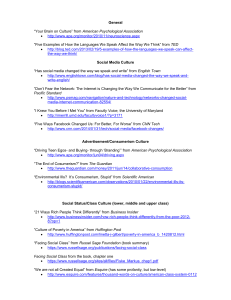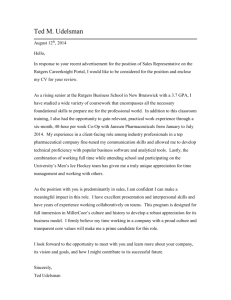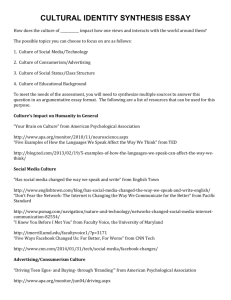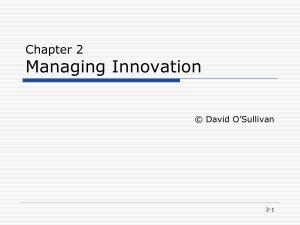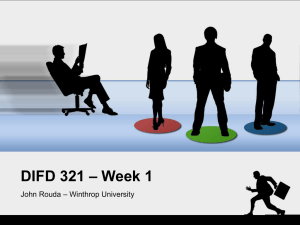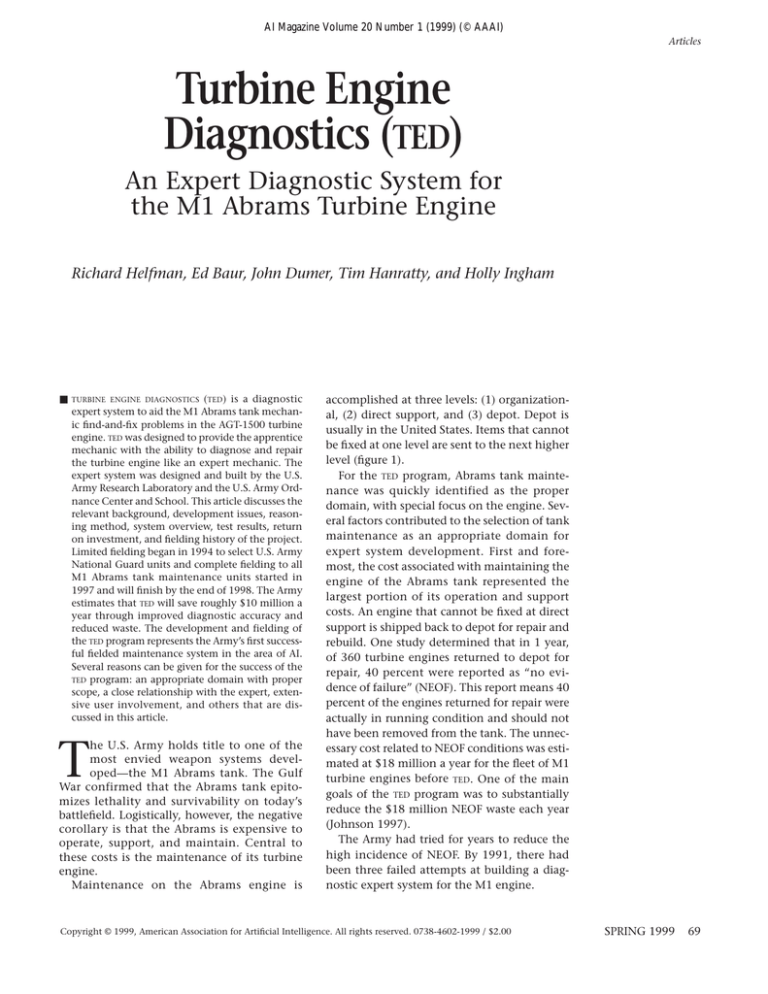
AI Magazine Volume 20 Number 1 (1999) (© AAAI)
Articles
Turbine Engine
Diagnostics (TED)
An Expert Diagnostic System for
the M1 Abrams Turbine Engine
Richard Helfman, Ed Baur, John Dumer, Tim Hanratty, and Holly Ingham
■
TURBINE ENGINE DIAGNOSTICS (TED) is a diagnostic
expert system to aid the M1 Abrams tank mechanic find-and-fix problems in the AGT-1500 turbine
engine. TED was designed to provide the apprentice
mechanic with the ability to diagnose and repair
the turbine engine like an expert mechanic. The
expert system was designed and built by the U.S.
Army Research Laboratory and the U.S. Army Ordnance Center and School. This article discusses the
relevant background, development issues, reasoning method, system overview, test results, return
on investment, and fielding history of the project.
Limited fielding began in 1994 to select U.S. Army
National Guard units and complete fielding to all
M1 Abrams tank maintenance units started in
1997 and will finish by the end of 1998. The Army
estimates that TED will save roughly $10 million a
year through improved diagnostic accuracy and
reduced waste. The development and fielding of
the TED program represents the Army’s first successful fielded maintenance system in the area of AI.
Several reasons can be given for the success of the
TED program: an appropriate domain with proper
scope, a close relationship with the expert, extensive user involvement, and others that are discussed in this article.
T
he U.S. Army holds title to one of the
most envied weapon systems developed—the M1 Abrams tank. The Gulf
War confirmed that the Abrams tank epitomizes lethality and survivability on today’s
battlefield. Logistically, however, the negative
corollary is that the Abrams is expensive to
operate, support, and maintain. Central to
these costs is the maintenance of its turbine
engine.
Maintenance on the Abrams engine is
accomplished at three levels: (1) organizational, (2) direct support, and (3) depot. Depot is
usually in the United States. Items that cannot
be fixed at one level are sent to the next higher
level (figure 1).
For the TED program, Abrams tank maintenance was quickly identified as the proper
domain, with special focus on the engine. Several factors contributed to the selection of tank
maintenance as an appropriate domain for
expert system development. First and foremost, the cost associated with maintaining the
engine of the Abrams tank represented the
largest portion of its operation and support
costs. An engine that cannot be fixed at direct
support is shipped back to depot for repair and
rebuild. One study determined that in 1 year,
of 360 turbine engines returned to depot for
repair, 40 percent were reported as “no evidence of failure” (NEOF). This report means 40
percent of the engines returned for repair were
actually in running condition and should not
have been removed from the tank. The unnecessary cost related to NEOF conditions was estimated at $18 million a year for the fleet of M1
turbine engines before TED. One of the main
goals of the TED program was to substantially
reduce the $18 million NEOF waste each year
(Johnson 1997).
The Army had tried for years to reduce the
high incidence of NEOF. By 1991, there had
been three failed attempts at building a diagnostic expert system for the M1 engine.
Copyright © 1999, American Association for Artificial Intelligence. All rights reserved. 0738-4602-1999 / $2.00
SPRING 1999
69
Articles
TED at Direct Support Level
Depot
Direct Support
Organizational
Figure 1. Maintenance-Level Military Structure.
Application Description
This section presents the system overview; system organization, including diagnostics, maintenance, bookkeeping, and training; hardware;
and software. Early in the project, the turbine
subject matter experts (SMEs) and the knowledge engineers at the U.S. Army Research Laboratory (ARL) established several design goals.
These goals were based primarily on the SMEs’
extensive experience as mechanics and
instructors for engine maintenance classes.
The SMEs had extensive experience with soldier mechanics—their likes and their dislikes.
The following paragraph presents the main
design goals for the TED software.
The software should be accurate, easy to use,
flexible, task oriented, and able to support
multiple levels of expertise.
First, the software should be accurate. It
need not be perfect, but it should be significantly better at diagnosing faults than the system it is replacing. Otherwise, it will lose soldier respect and will not be used. Second, it
must be easy to use; otherwise, it will sit on the
shelf. Mechanics have favorite stories of diagnostic equipment that does nothing but occupy lots of storage space. Third, it must be flexible enough to support a variety of diagnostic
styles. For example, some mechanics are thorough and methodical, and a structured stepby-step approach is best for them. A few have
a sixth sense and “know” what is wrong with
an engine. They have only limited need for the
information in TED and will only use it as an
70
AI MAGAZINE
occasional reference. Other soldiers have a
mixture of styles. They might know a lot about
some parts of the engine but need guidance in
other areas. Fourth, TED must be task structured
in a way that is natural for the soldier. The current technical manuals have a structure that is
difficult to use and follow. Experts can navigate the technical manuals, but others find the
structure confusing. Finally, the last goal recognizes that mechanics come with different
skill levels. Experts need little or no help from
TED . Beginners need extensive step-by-step
instructions. A system aimed at just one level
of expertise would bore the expert and baffle
the beginner.
System Organization
TED is organized into five functional areas that
represent the various actions performed by
M1 mechanics: (1) diagnostics, (2) repair
parts, (3) maintenance, (4) bookkeeping, and
(5) training.
The software allows multimode access,
either menu driven or data driven. The choice
is made by the soldier.
Diagnostics This functional area represents
the major share of the code in TED. It contains
14 modules that find out what is wrong with
the engine. The modules organize direct-support diagnostic logic by terms easily recognized
by mechanics, regardless of experience. Troubleshooting areas include No Start, Low Power,
High Oil Consumption, Engine Smokes, Metal
Contamination, Quick Coast Down, Idle
Faults, Engine Shutdown, Fault Finder, and
Protective modes. Each of the submodules contains diagnostic logic to first determine the
cause of the faulty symptom and, once the
cause has been detected, to link the appropriate
maintenance and repair parts modules.
Repair Parts
After a fault has been diagnosed, parts often need to be ordered. The second main module of TED is the repair parts and
special tools list (RPSTL) module. This module
greatly enhances the mechanics ability to
interrogate the parts-ordering information for
every aspect of the Abrams engine and transmission. Provided to the mechanic is the ability to search for items of interest in a variety of
ways. In addition to being automatically
linked from a diagnostic procedure, the
mechanic can peruse the system from a general table of contents or choose to search on specific part number, national stock number, or
nomenclature.
Displayed in figure 2 is a typical ordering
selection form. For each figure, its associated
parts list is displayed on the right side, and its
drawing is detailed on the left. Items are select-
Articles
Figure 2. Typical Parts-Ordering Screen.
ed from the parts list by buttoning the particular order box. When necessary, portions of a
drawing can be magnified to highlight areas of
interest. Information from the RPSTL is automatically associated with its corresponding
work order.
Maintenance Maintenance actions for any
component include adjust, repair, remove, and
replace. The procedures can be invoked in
either browse mode or data-driven mode.
When in browse mode, maintenance procedures are manually selected through menus
and submenus, providing experienced
mechanics with the flexibility to view only the
procedures that they need and bypass familiar
or routine tasks. When in the data- driven
mode, TED automatically establishes the correct
links to all pertinent maintenance procedures
and sections of the repair parts manual.
Bookkeeping All work done on an engine
must be documented, which is done automatically in TED. Found under the system administration module are the report writing and database-maintenance functions. In addition to
allowing the mechanic the ability to print the
necessary DA 2404 technical inspection form,
the system provides numerous work order and
statistical summaries. For database maintenance, routines to update and delete information are also available.
Training The first of the special applications
is the DIAGNOSTIC INTELLIGENT TUTORING SYSTEM
(DITS). DITS is an embedded tutorial system that
covers basic maintenance procedures, theory
of engine operations, and guidance on such
tasks as hooking up the ground hop support
set and using a multimeter. Using interactive
review and troubleshooting modules, mechanics can hone their skills in a field environment.
DITS, a diagnostic trainer, complements TED, a
diagnostic tool, by providing mechanics with a
complete system.
Hardware
An invariable factor associated with every software system developed is its hardware constraints. From the onset, careful consideration
must be given to the delivery platform (that is,
on what machine or machines will the system
reside). Where possible, the identification
should occur immediately. The earlier a target
machine is identified, the sooner the program
can capitalize on its strengths and minimize its
weaknesses. For many applications, selection
of the delivery platform is a moot point.
Where selection is possible, dialog with the
user is paramount, giving special consideration
to cost, the user’s environment, available software, and connectivity.
For the TED program, hardware constraints
were predetermined. The delivery platform
selected was a 80486 PC that was part of the
Army common computer hardware. The com-
SPRING 1999 71
Articles
Data input
Database
(beliefs)
Knowledge areas
(plans)
System Interfaces
Interpreter
(inference engine)
Goals
(desires)
Stack
(intentions)
Data output
The
knowledge is
represented
graphically
with
semantics
suited to the
procedural,
goal-oriented
style of
problem
solving and is
best suited for
problems that
are both
procedural
and goal
oriented
72
AI MAGAZINE
Figure 3. PRS Architecture.
puter has now been upgraded to a
laptop.
PENTIUM
Software
In the past, computer systems were typically
characterized by the proprietary coupling of
unique software to a specific hardware platform. Today, contemporary computer systems
are breaking the sole-source syndrome and
emphasizing greater interoperability and portability. The number of systems adopting the
“collection of components” approach, better
known as commercial off-the-shelf (COTS), is
increasing.
In general terms, COTS software supports a
large commercial following, is readily available, and easily meets or extends a system’s
capability requirements. Systems developed
using a COTS approach are generally less costly, quicker to be fielded, and more flexible than
products developed with non–COTS methods.
Limiting the COTS approach is the careful
examination that is required to correctly
match system requirements with the COTS
model, the potential for run-time fees, and the
need for specialized wrapper programs that
could exist. Although the true efficacy of COTS
products is not without bounds, the benefits
outweigh the costs.
For the TED program, the adoption of COTS
software was considered beneficial. Time was
judged better spent on knowledge acquisition
and testing than on pure code development.
Chosen as the primary subsystem was the
commercially available procedural-based expert system shell VISUAL EXPERT by Softsell. Additional features to the TED program are provided
by the COTS products from Visual Basic,
Access, Toolbook, and HyperWriter. In-house
code was developed with Microsoft C++ and
Borland’s DELPHI.
AI Technology
The main diagnostic software in TED is a WINDOWS -based shell called VISUAL EXPERT. VISUAL
EXPERT is based on a reasoning paradigm called
PROCEDURAL REASONING SYSTEM (PRS) (Georgeff
and Lansky 1986, 1983). PRS is a visual method
of encoding reasoning strategies used by
expert problem solvers. The knowledge is represented graphically with semantics suited to
the procedural, goal-oriented style of problem
solving and is best suited for problems that are
both procedural and goal oriented. A procedural approach uses an ordered step-by-step
prescription to obtain a desired result, possibly
including alternate paths in case of failure.
Such an approach is also goal oriented if some
steps are goals to be achieved rather than specific actions to be performed (ADS 1988). Army
technical manuals closely follow this paradigm. They are often graphic in nature, with
decision trees displayed on the page. Some
nodes represent goals to be achieved; others
represent specific tasks to be performed. These
tasks can themselves become goals whose solution is to be given on another page (or in
another manual) (Ingham et al. 1997).
PRS is endowed with the attitudes of belief,
desire, and intention (figure 3). The generalized system is composed of a system database,
a set of procedures or plans, an interpreter or
inference engine, and a process stack. The
database contains the current beliefs of the system. These beliefs could be static properties of
Articles
Rank
Manual Faults Detected (%)
E1–E4
26
52
E5
11
42
E6–E7
42
56
Overall
26
52
TED
Faults Detected (%)
Table 1. Field Test Results.
the domain or beliefs derived by the system
itself as it executes its plans. The plans are
descriptions of how to accomplish given goals
or react to certain situations and are represented by declarative procedure specifications. The
body of these procedures is represented as a
graphic network with sequences of subgoals to
be achieved as well as primitive actions to be
accomplished. The interpreter runs the entire
system, executing active goals and deciding
what course of action to take based on the
beliefs the system has at a point in time.
PRS combines features from several programming paradigms. Like PROLOG , it has
goal-directed inferencing and depth-first
search. Like expert system shells, it provides a
frame system for global objects. Like Lisp, it is
well suited for rapid prototyping. SMEs quickly learned how to read VISUAL EXPERT’s visual
code, and some began writing their own code
or modifying code written by the knowledge
engineers.
Application Use and Payoff
This section discusses formal testing, beta testing, and payoff.
Formal Testing
During the week of 15 to 21 August 1993, an
initial field test of the TED program was conducted at Fort Stewart, Georgia. Participating
in the test were 30 soldiers from the Tennessee
Army National Guard. Keeping in mind the
target audience (direct-support mechanics),
the test had two objectives: First was to measure how accurately and quickly mechanics
could identify randomly assigned faults on the
engine using TED versus technical manuals;
second was to decide if the program was soldier friendly. For the test, the 30 mechanics
were divided into 3 levels of 10 mechanics,
each based on their enlisted rank: E1 to E4, E5,
and E6 to E7.
Each mechanic inspected two engines, one
with TED and one with the technical manuals.
The engines had a random number of faults
installed from a randomized list of possible
faults. There was a one-hour time limit for each
inspection. An observer, with a score card, was
present with each mechanic to log faults and
the times that each fault was located. The conditions of the test approximated the actual
working environment of the mechanics. There
were three types of data collected during the
field test: (1) the observer’s score card (mentioned previously), which served as the basis
for the statistical analysis; (2) a questionnaire
completed by each mechanic, which allowed
him to express his impressions of TED; (3) the
observer’s recorded personal comments, which
served as an additional source of information
for further revisions.
At each level, TED outperformed the current
technical manual procedures (table 1). TED
assisted the junior enlisted (E1–E4) and the
junior noncommissioned officers (E5) in finding at least twice as many faults as the technical manuals. Note that even though TED is
designed for junior mechanics, senior mechanics (E6–E7) were able to increase their efficiency by using TED. Overall, the mechanics
demonstrated a 96-percent increase in their
ability to efficiently diagnose the engine (Tay-
SPRING 1999 73
Articles
Date
Jan. 1995
State (# units within state)
Texas (9), Tennessee (3), Missouri (1)
March 1995
Idaho (4), California (2), Colorado (1), Oregon (1), Washington (1)
May 1995
Mississippi (7), Louisiana (1), Kansas (1), Kentucky (2)
June 1995
Georgia (4), Alabama (2), Florida (1), South Carolina (1), New Jersey (2), New York (4),
Pennsylvania (3), Vermont (1)
Sept. 1995
Iowa (2), Ohio (2), Michigan (2), Minnesota (1), Montana (2), North Carolina (2),
Virginia (2), West Virginia (1), Wisconsin (1)
Table 2. A Total of 66 National Guard Units in 29 States Beta Tested the TED System.
lor and Monyak 1994).
The ease of use became readily apparent to
the observers during the initial training session. Because many of the mechanics had never used a computer, the observers allocated a
one-hour training block for each mechanic. In
less than 10 minutes, mechanics who had never used a computer were effectively maneuvering through the software and hardware. Soldier acceptance was also unanimously
positive. Both computer- and noncomputerliterate mechanics readily accepted TED as the
preferred tool for maintaining the engine
(Baur et al. 1996).
Beta Testing
Based on the success of the 1993 tests, the
National Guard agreed to become beta testers
for TED. In 1994, two states, Tennessee and
Georgia, were given early copies of two TED
software modules for testing. During 1995 and
1996, ARL delivered TED software and training
to a total of 66 National Guard units in 29
states, as shown in table 2.
In early 1997, TED was sufficiently developed
and tested to be released to units in the active
Army. By the end of 1998, there will be a total
of 200 copies of TED in use by the National
Guard, the United States Marines, and the
active Army.
Payoff
The goal of the TED program is to save money
by reducing the diagnostic error rate. An 80percent error reduction will save roughly $10
million each year by avoiding unneeded
repair. The TED program is on its way to achieving this goal.
In 1993, the University of Delaware conducted a formal user test using 30 soldiers from the
74
AI MAGAZINE
Tennessee National Guard. The results showed
that TED cut the error rate by 50 percent.
In the summer of 1994, units from two different state National Guards received early versions of the TED software. Each state had three
broken engines slated for turn-in. Each state
had diagnosed the bad engines before TED
arrived. On Saturday, 9 July, TED was used on
the three engines from one state and on Sunday, 10 July, on the three engines from the other state. On all six engines, the pre–TED diagnosis was wrong, and the TED diagnosis was right.
Thus, in the first two days of fielding, TED saved
the Guard six incorrect engine repairs at a cost
savings of over $50,000.
By the summer of 1996, TED diagnostics had
error rates well below 5 percent.
Application Development
and Deployment
This section presents the history and development guidelines, including communications,
prototyping, and the model.
History
The TED program started in 1991 at the U.S.
Army Ordnance Center and School (OC&S) as
an effort to seek solutions to some of the
maintenance problems the Army was having
with its equipment. ARL joined the program
in the summer of 1991 as knowledge engineers and technical advisers, with OC&S supplying the SMEs to provide the expert diagnostic knowledge and guide the development
direction of the system. OC&S also supplied
engines and soldiers as needed to test the new
software being developed.
The first TED prototype was ready by Janu-
Articles
ary 1992. For the next 18 months, existing
modules were expanded, and new modules
were begun. In March 1993, the TED program
was nominated for and received the American
Defense Preparedness Association’s award for
outstanding logistics and AI application. By
August of the same year, the program was sufficiently developed to warrant formal field
testing. Preliminary results showed TED
improved fault identification by 96 percent
over the older technical manual methods.
In January 1994, Program Manager-Abrams
(PM-Abrams), the primary proponent for the
Abrams tank, decided to field TED to all active
direct-support units with Abrams tanks. In
addition, further production of paper manuals for the AGT1500 engine was halted. By
March of the same year, the National Guard
Bureau asked to have TED for its National
Guard units as soon as possible. Fielding to
the first two National Guard units (Georgia
and Tennessee) began in July 1994. The
National Guard Bureau continued to incrementally field TED until 65 units in 29 states
with Abrams tanks had the TED software.
Development Guidelines
The TED software engineers quickly established
some important guidelines that remain in
effect today.
Establish and Maintain Communication Software engineers and SMEs do not
generally speak the same language. Software
engineers talk of frames and objects. The SMEs
for the TED program are M1 tank mechanics.
M1 tank mechanics talk of inlet guide vane
(IGV) angles and rotational variable differential transformers. (RVDTs). Each needs to learn
some of the other’s language, but the main
effort is on the software engineer to learn the
language of the mechanic.
The best way to learn what the user does is
to observe the user in his environment. The
TED team attended and videotaped classes for
M1 mechanics, producing three important
benefits: First, it quickly immersed the software engineers into the language of the
mechanic. The IGV is located in front of the
engine, and the angle determines how much
air gets through to the turbine blades. Second,
it gave an accurate picture of how a mechanic
performs his job and how software might
improve this job. The TED team noticed during
this first session that the original scope of work
was too narrow. There was a whole suite of
software that could help the mechanic better
perform his job. Third, it established a bond
between the software engineer and the soldier.
Soldiers could sense that the team was serious
and that soldiers’ needs would be given serious
attention. They were thus eager to cooperate.
When the aim is to produce software that
not only works as planned but also gets used
by the mechanic, then user participation in
the development process is critical. The TED
team heard many stories from soldiers about
equipment that never gets used and equipment that is difficult to use but with a small
change would have made the item soldier
friendly. The TED SMEs were assigned full time
to the project.
New technology is often met with resistance
when it is thrown at an unaware or ill-prepared
user. Rarely can a user, at the start of a project,
envision how technology can improve his job.
A system based on initial user expectations will
at best be shallow and might even be useless.
The software engineer and the SME are each
constantly learning about the other. The software engineer is continually learning about
the needs and duties of the mechanic, and the
mechanic is learning about the potential
impact of new software on his future.
Rapid Prototyping A prototype is essential
for two-way communication. It allows the user
to see and touch what the software engineer
envisions for the user. It gives the user the earliest opportunity to comment on his system,
and it gives him some clue as to the potential
of the project. The user does not always know
what technology is available, and the handson experience of the prototype is often the
best way to educate the user. A prototype
serves as a common reference point. Without
a prototype, not much useful feedback can
occur. It also shows how well the software
engineer understands the user’s needs.
Spiral Model
Boehm’s (1986) spiral model
incorporates an incremental development
schema. Successive prototypes are produced
that expand on user requirements. In addition,
the software engineer is able to break down
complex tasks into smaller components. As
each component is developed, it is evaluated
against user requirements. The user requirements are reevaluated as each successive module is developed. Consequently, the user is an
integral part of the development team. His
input is essential. There are two reasons
behind selecting the spiral method for the TED
program: (1) rapid changes in PC hardware
and software and (2) the need to keep the user
in the loop. In 1991, it was obvious that hardware and software for the PC would continue
to improve and become more affordable. Computer memory continues to expand and
deflate in price. Hard drives continue to get
bigger and cheaper. Screen resolution expands,
The TED team
continues to
meet formally
once a month
to decide on
the direction
and scope of
the project.
Unsatisfied
goals are
reevaluated,
and some
might be
dropped from
the list, and
new goals
might be
added.
SPRING 1999 75
Articles
and video cards improve. The price of a PENTIUM system today rivals the price of a 386 system in 1991.
Software follows the same pattern outlined
for hardware. Every year, software improves,
new products are announced, and existing
products offer upgrades at an astounding pace
and price. Goals that were impossible or difficult in the past might now be relatively easy
tasks. The TED team continues to meet formally
once a month to decide on the direction and
scope of the project. Unsatisfied goals are
reevaluated, and some might be dropped from
the list, and new goals might be added.
Software Maintenance
The incremental design used for TED incorporates software maintenance into the process.
Early software modules have been in use since
1994, and the last software was delivered in
September 1996. ARL continues to receive bug
reports and wish lists from the field, although
these have diminished significantly. ARL is
now training other Army personnel to take
over the maintenance of the TED program. For
more information, visit the TED web site at
RPSTL.ARL.MIL/TED.HTML.
References
ADS. 1988. Procedural Reasoning Systems. Working
Paper, TR-ADS-0015. Advanced Decision Systems,
Mountain View, California.
Baur, E.; Dumer, J.; Hanratty, T.; Helfman, R.; and
Ingham, H. 1996. Technology and Tank Maintenance. Expert Systems with Applications 11(2): 99–107.
Boehm, B. W. 1986. A Spiral Model of Software
Development and Enhancement. ACM Software
Engineering Notes, August, 14–24. New York: Association of Computing Machinery.
Georgeff, M. P., and Lansky, A. L. 1986. A System of
Reasoning in Dynamic Domains: Fault Diagnostics
on the Space Shuttle. Technical Notes, 375, SRI International, Menlo Park, California.
Georgeff, M. P., and Lansky, A. L. 1983. Procedural
Expert Systems. In Proceedings of the Eighth International Joint Conference on Artificial Intelligence,
151–157. Menlo Park, Calif.: International Joint
Conferences on Artificial Intelligence.
Ingham, H.; Helfman, R.; Hanratty, T.; Dumer, J.; and
Baur, E. 1997. TED—A Practical Application of a Diagnostic Expert System. In IEEE Proceedings of the
Ninth International Conference on Tools with Artificial Intelligence, 438–445. Washington, D.C.: Institute of Electrical and Electronics Engineers.
Johnson, C. J. 1997. Meet TED, The Army’s Computerized Tank Mechanic. Program Manager Magazine
26(3): 2–13.
Taylor, M. S., and Monyak, J. T. 1994. Statistical
Analysis of Turbine Engine Diagnostic (TED) Field
Test Data. Technical Report, ARL-TR-614. U.S. Army
76
AI MAGAZINE
Research Laboratory, Aberdeen Proving Ground,
Maryland.
Richard Helfman is team leader
for the U.S. Army Research Laboratory’s Turbine Engine Diagnostic
Knowledge Engineering Group.
His principal work is in the area of
applied AI, with research interests
in formal reasoning and representation. Helfman received his B.A.
in mathematics in 1967 from the
University of Minnesota, his M.A. in mathematics
from the University of Colorado in 1970, and his
Ph.D. in mathematics from the University of Montana in 1980. His e-mail address is helfman@arl.mil.
Edmund Baur is a computer scientist at the U.S. Army Research
Laboratory. He received his bachelor’s degree in aerospace engineering from the University of Cincinnati and a Master’s degree in
computer science from The Johns
Hopkins University. He has been
employed at the Army Research
Laboratory since 1980 and currently researches webbased expert system technologies. His e-mail address
is baur@arl.mil.
John Dumer is a computer scientist at the U.S. Army Research Laboratory. His principal research
areas include fuzzy logic, reasoning under uncertainty, and cooperative expert system technologies. Dumer holds a B.S. in
computer science–communications from Towson University. His
e-mail address is dumer@arl.mil.
Timothy Hanratty is a computer
scientist at the U.S. Army Research
Laboratory. His professional interest focuses on applied research
and development in the areas of
knowledge engineering and decision support technology. Hanratty
received his B.S. in computer science from Towson University and
his M.S. from The Johns Hopkins University. His email address is hanratty@arl.mil.
Holly Ingham is a computer scientist at the U.S. Army Research Laboratory. Her research interests
include expert system design and
the application of AI techniques to
the areas of diagnostics and prognostics. She received her B.S. in
physics in 1986 and an M.S. in
computer science in 1997, both
from Towson University. Her e-mail is hollyo@arl.mil.


